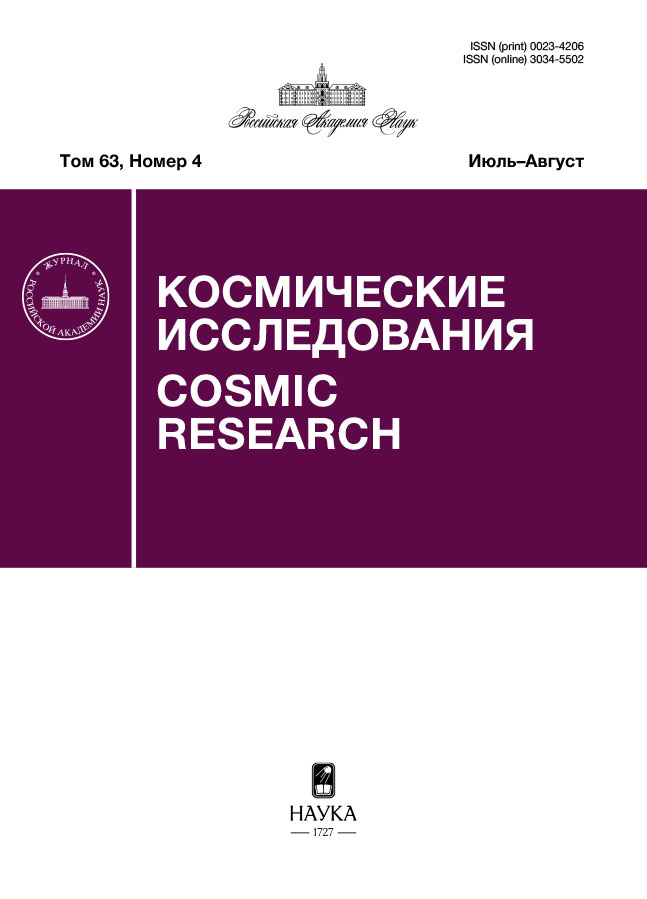Исследование движения группы из четырех связанных космических аппаратов под управлением с использованием сил Лоренца
- Авторы: Чернов К.С.1, Иванов Д.С.1
-
Учреждения:
- Институт прикладной математики им. М.В. Келдыша РАН
- Выпуск: Том 61, № 4 (2023)
- Страницы: 339-352
- Раздел: Статьи
- URL: https://rjsocmed.com/0023-4206/article/view/672640
- DOI: https://doi.org/10.31857/S0023420623600022
- EDN: https://elibrary.ru/UMATAE
- ID: 672640
Цитировать
Полный текст
Аннотация
В работе рассматриваются четыре космических аппарата, соединенные друг с другом электродинамическими тросами, которые при математическом моделировании движения системы считаются жесткими. В магнитном поле Земли на проводники с током действуют силы Лоренца, с использованием которых производится управление движением центра масс системы и угловым движением. В работе разработан алгоритм расчета величин сил тока для остановки дрейфа центра масс тетраэдральной формации относительно опорной орбитальной системы координат на низкой околоземной орбите и для раскрутки относительно центра масс до постоянной угловой скорости. Проводится численное исследование времени достижения заданного движения в зависимости от максимально возможной силы тока и начальных условий.
Об авторах
К. С. Чернов
Институт прикладной математики им. М.В. Келдыша РАН
Email: chernow.kirill@gmail.com
Россия, Москва
Д. С. Иванов
Институт прикладной математики им. М.В. Келдыша РАН
Автор, ответственный за переписку.
Email: chernow.kirill@gmail.com
Россия, Москва
Список литературы
- Shirobokov M.G., Trofimov S.P. Adaptive Neural Formation-Keeping Control for Satellites in a Low-Earth Orbit // Cosmic Research. 2021. V. 59. Iss. 6. P. 501–516. https://doi.org/10.1134/S0010952521060113
- Leonard C.L. Formationkeeping of Spacecraft via Differential Drag. Master Thesis. Massachusetts Inst. Technol., 1986. http://hdl.handle.net/1721.1/13358
- Mashtakov Y., Ovchinnikov M., Petrova T. et al. Two-satellite formation flying control by cell-structured solar sail // Acta Astronaut. 2020. V. 170. P. 592–600. https://doi.org/10.1016/j.actaastro.2020.02.024
- Ivanov D., Gondar R., Monakhova U. et al. Electromagnetic uncoordinated control of a ChipSats swarm using magnetorquers // Acta Astronaut. 2022. V. 192. P. 15–29. https://doi.org/10.1016/j.actaastro.2021.12.014
- Shestakov S., Ivanov D., Ovchinnikov M. Formation-Flying Momentum Exchange Control by Separate Mass // J. Guid. Control. Dyn. 2015. V. 38. Iss. 8. P. 1–10. https://doi.org/10.2514/1.G001137
- Peck M.A., Streetman B., Saaj C.M., Lappas V. Spacecrat Formation Flying Using Lorentz Forces // J. Br. Interplanet. Soc. 2007. V. 60. Iss. 7. P. 263–267.
- Peck M.A. Prospects and challenges for Lorentz-augmented orbits // Collect. Tech. Papers – AIAA Guid. Navig. Control Conf. 2005. V. 3. P. 1631–1646. https://doi.org/10.2514/6.2005-5995
- Schaffer L., Burns J.A. Charged dust in planetary magnetospheres: Hamiltonian dynamics and numerical simulations for highly charged grains // J. Geophys. Res. SP. Phys. 1994. V. 99. Iss. A9. P. 17211–17223.https://doi.org/10.1029/94JA01231
- Saaj C.M., Lappas V., Richie D. et al. Electrostatic forces for satellite swarm navigation and reconfiguration. Final report for Ariadna Study Id. AO 4919 05. ESA, 2006. 96 p.
- Liu J., Gangqiang L., Zhu Z.H. et al. Automatic orbital maneuver for mega-constellations maintenance with electrodynamic tethers // Aerospace Science and Technology. 2020. V. 105. Art. ID. 105910. https://doi.org/10.1016/j.ast.2020.105910
- Yang Y.-W., Cai H. Extended time–delay autosynchronization method for libration control of electrodynamic tether using Lorentz force // Acta Astronaut. 2019. V. 159. P. 179–188. https://doi.org/10.1016/j.actaastro.2019.03.038
- Lu H., Li A., Wang C., Zabolotnov Y. Stability analysis and motion control of spinning electrodynamic tether system during transition into spin // Acta Astronaut. 2020. V. 177. 2019. P. 871–881. https://doi.org/10.1016/j.actaastro.2019.11.032
- Voevodin P.S., Zabolotnov Y.M. Analysis of the Dynamics and Choice of Parameters of an Electrodynamic Space Tether System in the Thrust Generation Mode // Cosm. Res. 2020. V. 58. Iss. 1. P. 42–52. https://doi.org/10.1134/S0010952520010062
- Ohkawa Y., Kawamoto S., Okumura T. et al. Review of KITE – Electrodynamic tether experiment on the H-II Transfer Vehicle // Acta Astronaut. 2020. V. 177. 2019. P. 750–758. https://doi.org/10.1016/j.actaastro.2020.03.014
- Kalenova V.I., Morozov V.M. Stabilization of Satellite Relative Equilibrium Using Magnetic and Lorentzian Moments // Cosm. Res. 2021. V. 59. Iss. 5. P. 343–356. https://doi.org/10.1134/S0010952521050051
- Alexandrov A.Y., Tikhonov A.A. Electrodynamic Control with Distributed Delay for AES Stabilization in an Equatorial Orbit // Cosm. Res. 2022. V. 60. Iss. 5. P. 366–374. https://doi.org/10.1134/S0010952522040013
- Kalenova V.I., Morozov V.M. Novel approach to attitude stabilization of satellite using geomagnetic Lorentz forces // Aerospace Science and Technology. 2020. V. 106. Iss. 1. Art. ID. 106105. https://doi.org/10.1016/j.ast.2020.106105
- Guzmán J.J., Edery A. Mission design for the MMS tetrahedron formation // IEEE Aerosp. Conf. Proc. 2004. V. 1. P. 533–540. https://doi.org/10.1109/AERO.2004.1367637
- Shestakov S., Ovchinnikov M., Mashtakov Y. Analytical approach to construction of tetrahedral satellite formation // J. Guid. Control. Dyn. 2019. V. 42. Iss. 12. P. 2600–2614. https://doi.org/10.2514/1.G003913
- Guerman A.D., Smirnov G.V., Paglione P., Seabra A.M.V. Stationary configurations of a tetrahedral tethered satellite formation // J. Guid. Control. Dyn. 2008. V. 31. Iss. 2. P. 424–428. https://doi.org/10.2514/1.31979
- Hill G.W. Researches in the Lunar Theory // Am. J. Math. 1878. V. 1. P. 5–26.
- Ivanov D., Monakhova U., Ovchinnikov M. Nanosatellites swarm deployment using decentralized differential drag-based control with communicational constraints // Acta Astronaut. 2019. V. 159. P. 646–657. https://doi.org/10.1016/j.actaastro.2019.02.006
- Mashtakov Y.V., Ovchinnikov M.Y., Tkachev S.S. Study of the disturbances effect on small satellite route tracking accuracy // Acta Astronaut. 2016. V. 129. P. 22–31. https://doi.org/10.1016/j.actaastro.2016.08.028
- Барбашин Е.А. Введение в теорию устойчивости. М.: Наука, 1967.
- Кюнци Г.П., Крелле В. Нелинейное программирование. М.: Советское радио, 1965.
Дополнительные файлы























